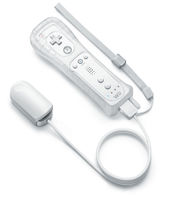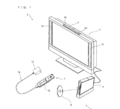| Site Notice |
|---|
|
We have a limited coverage policy. Please check our coverage page to see which articles are allowed. |
Difference between revisions of "Wii Vitality Sensor"
m |
m |
||
| Line 7: | Line 7: | ||
|model=N/A | |model=N/A | ||
}} | }} | ||
| − | The '''Wii Vitality Sensor''' was an unreleased {{wp|Pulse oximetry|pulse oximiter}} accessory for the [[Wii]], which would have allowed the console to detect the user's pulse during gameplay and provide that information to them. Originally announced at [[Electronic Entertainment Expo 2009|E3 2009]]<ref>[http://www.1up.com/news/satoru-iwata-announces-wii-vitality Satoru Iwata Announces Wii Vitality Sensor]. 1UP.com (June 2, 2009). Retrieved October 18, 2016.</ref>, it was later reconfirmed at [[Electronic Entertainment Expo 2011|E3 2011]]. However, at an investor's meeting in July 2013, [[Satoru Iwata]] confirmed that development had ceased on the Wii Vitality Sensor as the device did not work on approximately 10% of the people who tested it and did not have as widespread application as originally expected | + | The '''Wii Vitality Sensor''' was an unreleased {{wp|Pulse oximetry|pulse oximiter}} accessory for the [[Wii]], which would have allowed the console to detect the user's pulse during gameplay and provide that information to them. Originally announced at [[Electronic Entertainment Expo 2009|E3 2009]]<ref>[http://www.1up.com/news/satoru-iwata-announces-wii-vitality Satoru Iwata Announces Wii Vitality Sensor]. 1UP.com (June 2, 2009). Retrieved October 18, 2016.</ref>, it was later reconfirmed at [[Electronic Entertainment Expo 2011|E3 2011]]. However, at an investor's meeting in July 2013, [[Satoru Iwata]] confirmed that development had ceased on the Wii Vitality Sensor as the device did not work on approximately 10% of the people who tested it and did not have as widespread application as originally expected. While the project was deemed "insufficient as a commercial product", Iwata also stated that the company may possibly return to the project if the technology improves to work with "999 out of 1,000" people.<ref>[https://www.nintendo.co.jp/ir/en/stock/meeting/130627qa/03.html The 73rd Annual General Meeting of Shareholders Q & A]. Nintendo (July 3, 2013). Retrieved October 18, 2016.</ref> |
==Features and functionality== | ==Features and functionality== | ||
Latest revision as of 21:24, 6 May 2017
| Wii Vitality Sensor | ||||||||
|---|---|---|---|---|---|---|---|---|
| ||||||||
|
The Wii Vitality Sensor was an unreleased pulse oximiter accessory for the Wii, which would have allowed the console to detect the user's pulse during gameplay and provide that information to them. Originally announced at E3 2009[1], it was later reconfirmed at E3 2011. However, at an investor's meeting in July 2013, Satoru Iwata confirmed that development had ceased on the Wii Vitality Sensor as the device did not work on approximately 10% of the people who tested it and did not have as widespread application as originally expected. While the project was deemed "insufficient as a commercial product", Iwata also stated that the company may possibly return to the project if the technology improves to work with "999 out of 1,000" people.[2]
Features and functionality
The Wii Vitality Sensor resembles a fingertip pulse oximeter, which measures the user's vital signs in order to, according to Satoru Iwata, allow the user to relax and see the "inner world" of their body.[3] The device connects to the Wii Remote's expansion port in order to function.
Gallery
References
- ↑ Satoru Iwata Announces Wii Vitality Sensor. 1UP.com (June 2, 2009). Retrieved October 18, 2016.
- ↑ The 73rd Annual General Meeting of Shareholders Q & A. Nintendo (July 3, 2013). Retrieved October 18, 2016.
- ↑ The Wii Vitality Sensor Seems...Nice. Kotaku (June 2, 2009). Retrieved October 18, 2016.
|
| ||||||||||||||



